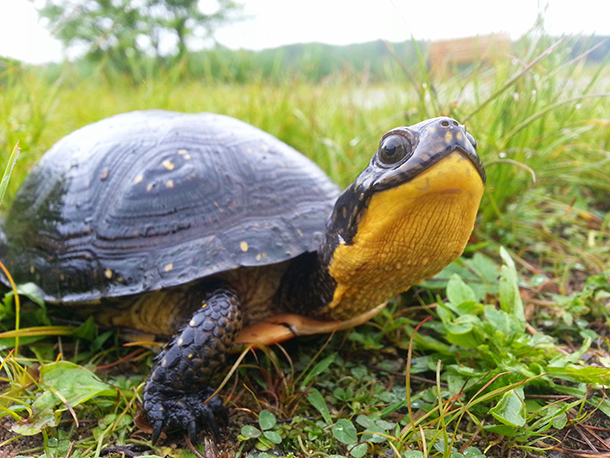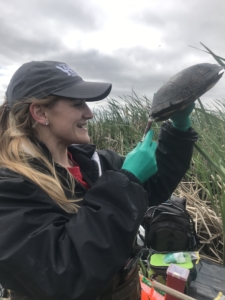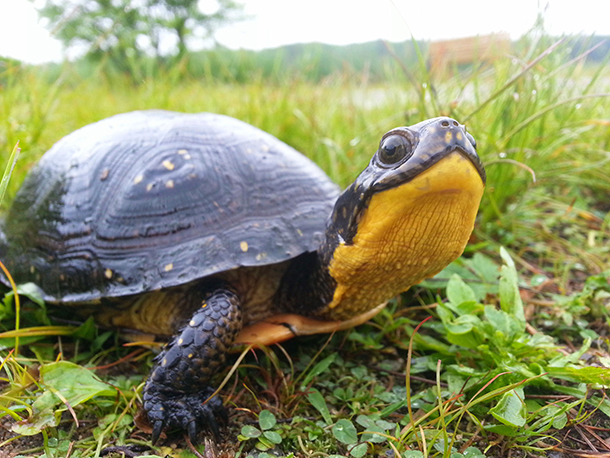You may be wondering, what is the point of this project? What is so special about the Blanding’s turtle? Here is the scoop on Blanding’s turtles and why they need our help!
A Background on Blanding’s

Blanding’s turtles (Emydoidea blandingii) are best known for their brilliant yellow chin and throat, and their notched upper jaw, giving the appearance that they are always smiling. These beautiful turtles are the only species in their genus, Emydoidea, but they belong to the same family as red eared sliders and painted turtles (Emydidae). Blanding’s are found across North America, centered around the Great Lakes region. They are considered semi-aquatic, meaning they inhabit mosaic landscapes of upland habitat and both permanent and temporary bodies of water. On average, an individual Blanding’s turtle utilizes more than 6 different wetlands each year and prefers those with a mixture of open water and emergent vegetation such as cattails and sedges. Shallow water with lots of sun exposure and basking sites are important characteristics of their wetland habitat. They frequently move between wetlands and upland sites to locate food, mating partners, and nesting locations. These turtles are opportunistic omnivores, feeding on a variety of snails, crayfish, tadpoles, earthworms, leeches, fish, frogs, and plant material. Blanding’s turtles are a long-lived species (>70yrs) and reach sexual maturity later in life, around 14-20 years old. Thus, adult survival is crucial to population success. Mature female Blanding’s turtles typically lay an average of 10-14 eggs each year, though many of these do not survive to adulthood. The Blanding’s turtle’s life history strategy requires high juvenile survival rates and very high adult survival rates to maintain a viable population. Adult survival rates lower than 90% result in population decline and unfortunately, this is common in many populations.

Endangered Emydoidea
Blanding’s turtle populations continue to decline throughout their home range. In all states where it naturally occurs, the Blanding’s turtle is now listed as endangered, threatened, or a species of concern. In 2009, it was elevated from Threatened to Endangered in the state of Illinois by the International Union for Conservation of Nature (IUCN).
The greatest threat Blanding’s face is extensive habitat loss and fragmentation due to increasing human populations and expanding urban development. What wetland and nesting habitat is left, is subject to degradation. Agriculture, transportation infrastructure, and water management practices all influence water flow through wetlands while invasive plant species and vegetation encroachment decrease the amount of bare soil available for nesting. Road mortality, increased predation, loss of genetic diversity, and pollution are all known factors causing significant population decrease as well. Blanding’s turtles crossing the road or train tracks to reach other wetland habitat or nesting sites are often struck by cars or overheat on railroads. Where there are more humans, there are more raccoons and other mesopredators that thrive in developed areas, leading to increased nest predation of up to 100%. All of these factors significantly decrease annual recruitment of new baby Blanding’s turtles and negatively affect the health and survival of adults.

One factor that has yet to be appropriately explored is the role of disease in Blanding’s turtle population decline. With so many threats to their already dwindling populations, targeted conservation actions are more important now than ever. Forest preserve districts of the Chicagoland area, including the Forest Preserve District of Kane County (FPDKC), are ramping up efforts to investigate and preserve the populations of Blanding’s turtles in their regions. Current management and recovery practices in place include population monitoring, habitat protection and restoration, nest preservation, and head-starting (egg incubation and rearing of hatchlings to improve survival rates).

To enhance these conservation efforts, forest preserve districts of Lake, Cook, DuPage, and Kane counties are investing in thorough studies investigating the health status of Blanding’s turtle populations in order to identify potential health threats and conservation solutions. Due to the small number of Blanding’s turtles in Kane County, populations of the more abundant painted turtles will also be sampled. Since these two species are closely related, painted turtle health will be evaluated to determine their population health status, as well as whether they may be used as a surrogate for health of Blanding’s turtles. This study will provide a baseline health assessment of four Kane County Blanding’s turtle and co-occurring painted turtle populations by evaluating each individual for signs of clinical disease, testing for pathogens, and monitoring bloodwork values.
Resources:
Illinois Natural History Survey. 2016. Conservation guidance for Blanding’s Turtle (Emydoidea blandingii). Report prepared for the Illinois Department of Natural Resources, Division of Natural Heritage.
van Dijk, P.P. & Rhodin, A.G.J. 2011. Emydoidea blandingii (errata version published in 2019). The IUCN Red List of Threatened Species 2011: e.T7709A155088836.

